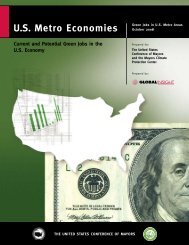Mineral Commodity Summaries 2011 - Environmental and Energy ...
Mineral Commodity Summaries 2011 - Environmental and Energy ...
Mineral Commodity Summaries 2011 - Environmental and Energy ...
You also want an ePaper? Increase the reach of your titles
YUMPU automatically turns print PDFs into web optimized ePapers that Google loves.
BORON33Events, Trends, <strong>and</strong> Issues: The global economic downturn in the last quarter of 2008 <strong>and</strong> through most of 2009negatively affected sectors vital for boron consumption, such as the construction <strong>and</strong> automotive industries. Themoderate economic recovery in 2010 created steady growth in boron production <strong>and</strong> consumption. Dem<strong>and</strong> forfiberglass, the principle use of boron, was expected to increase 2.3% annually through 2012. Consumption of boronused in high-technical fiberglass sectors, such as in electronic products <strong>and</strong> wind turbines, was expected to increaseby 10% in North America <strong>and</strong> by 13% in Europe by 2012. Dem<strong>and</strong> for borates was expected to shift slightly awayfrom detergents <strong>and</strong> soaps towards glass <strong>and</strong> ceramics.Although borate consumption in China decreased in 2009 owing to the economic downturn, consumption wasprojected to increase driven by dem<strong>and</strong> from its domestic ceramic <strong>and</strong> glass industries. With low-grade domesticboron reserves <strong>and</strong> the anticipated rise in dem<strong>and</strong>, Chinese imports from Chile, Russia, Turkey, <strong>and</strong> the UnitedStates were expected to increase over the next several years. Europe <strong>and</strong> emerging markets were requiring morestringent building st<strong>and</strong>ards with respect to heat conservation, which directly correlates to higher consumption ofborates for insulation fiberglass. Continued investment in new refineries <strong>and</strong> technologies <strong>and</strong> the continued rise indem<strong>and</strong> were expected to fuel growth in world production over the next several years.World Production <strong>and</strong> Reserves: Revisions to reserves estimates for Chile <strong>and</strong> China are based on newinformation from those countries.Production—All forms 4 Reserves 520092010 eUnited States W W 40,000Argentina 750 800 2,000Bolivia 83 92 NAChile 608 650 35,000China 145 150 32,000Iran 2 2 1,000Kazakhstan 30 30 NAPeru 187 170 4,000Russia 400 400 40,000Turkey 1,300 1,20060,000World total (rounded)3,5103,500 210,000World Resources: Large deposits of boron resources containing high B 2 O 3 content occur in southern California <strong>and</strong>in Turkey. U.S. deposits consist primarily of tincal, kernite, <strong>and</strong> borates contained in brines, <strong>and</strong> to a lesser extentulexite <strong>and</strong> colemanite. About 70% of all Turkish deposits are colemanite. Small deposits are being mined in SouthAmerica. At current levels of consumption, world resources are adequate for the foreseeable future.Substitutes: The substitution of other materials for boron is possible in detergents, enamel, insulation, <strong>and</strong> soaps.Sodium percarbonate can replace borates in detergents <strong>and</strong> requires lower temperatures to undergo hydrolysis,which is an environmental consideration. Some enamels can use other glass-producing substances, such asphosphates. Insulation substitutes include cellulose, foams, <strong>and</strong> mineral wools. In soaps, sodium <strong>and</strong> potassium saltsof fatty acids can act as cleaning <strong>and</strong> emulsifying agents.e Estimated. E Net exporter. NA Not available. W Withheld to avoid disclosing company proprietary data.1 <strong>Mineral</strong>s <strong>and</strong> compounds sold or used by producers; includes both actual mine production <strong>and</strong> marketable products.2 Less than ½ unit.3 Defined as imports – exports + adjustments for Government <strong>and</strong> industry stock changes.4 Gross weight of ore in thous<strong>and</strong> metric tons.5 See Appendix C for resource/reserve definitions <strong>and</strong> information concerning data sources.6 Excludes U.S. production.U.S. Geological Survey, <strong>Mineral</strong> <strong>Commodity</strong> <strong>Summaries</strong>, January <strong>2011</strong>







